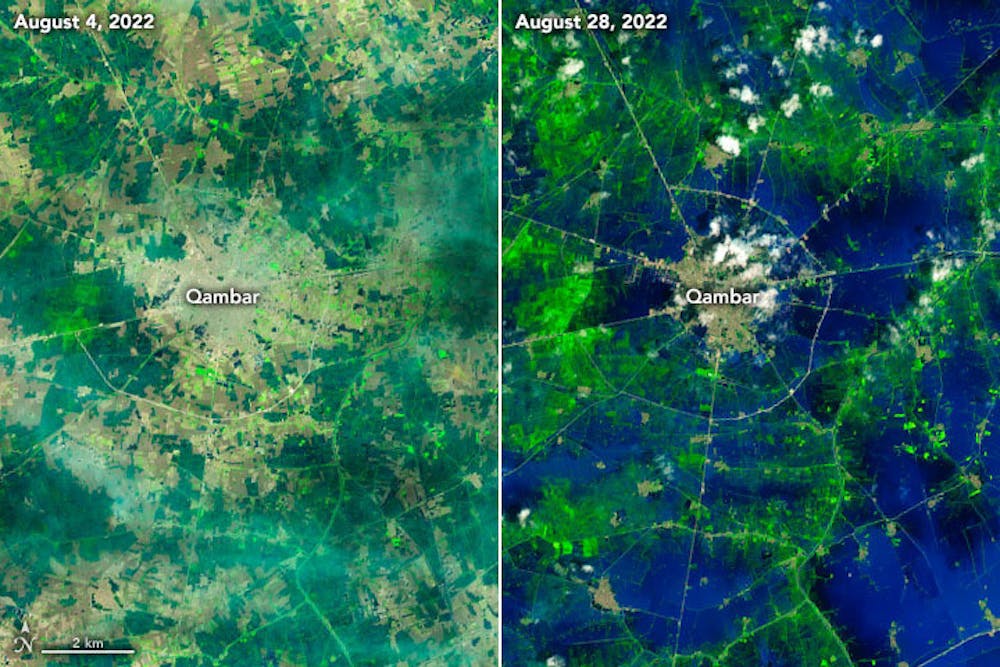
Starting in mid-June of this year, the increased intensity of monsoon rains have led to flooding conditions over certain parts of Pakistan. A monsoon can refer to the rainy season created by a change in wind patterns or a dry season. However, in Asian regions, monsoons mainly refer to the rainy season. But how is climate change connected to these floods?
To learn more about how climate change could have affected the floods, I spoke with Naveeda Khan, an associate professor of anthropology at Hopkins who also focuses some of her studies on climate change in Pakistan.
According to Naveeda Khan, global warming affects precipitation patterns by increasing the concentration of greenhouse gases in the air, which hold heat to a greater extent. This warmer air captures and holds the moisture longer, preventing regular rain and promoting heavy monsoons. Due to the increased amount of rain, the land is not able to absorb that much water, leading to flooding. As a result, climate change could change the once-rare floods to not only be more frequent but more intense.
Because most of Pakistan’s major cities lie near the river, the flooding can affect Pakistan's populations heavily. According to NASA, regions around the Indus River, including Punjab, Khyber and Sindh, have taken a huge hit, with some provinces like Balochistan and Sindh receiving almost five to six times their usual rainfall. While the flooding itself was caused by heavy monsoon rains, the exacerbation of this monsoon season may be partially attributable to climate change.
Naveeda Khan also noted her belief that the accelerated melting of Pakistan’s glaciers have contributed to the flooding. Usually, the glaciers melt and reform according to seasonal changes. With global warming, however, these glaciers are more prone to melt and less likely to reform to the same extent, leading to more flooding.
“In this instance it’s not the scale or frequency of the floods that is worrying, but that if glaciers melt precipitously, then that will mean permanent water loss for the human and non-human populations living around them,” she said.
Another topic of discussion around the etiological causes behind Pakistan's flooding includes the higher contribution of wealthier countries to global warming and climate change. Pakistan is estimated to contribute approximately 1% of the world’s carbon emissions. Looking at historical data around national contributions to global carbon emissions, countries like the U.S., China and Russia produce the most carbon emissions.
Naveeda Khan encouraged wealthier countries to make changes first, especially considering that they have the resources to do so and account for the majority of carbon emissions.
“If you look at the problem historically and from a justice perspective, then of course you think that countries of the Global North should bear the greater burden of reducing their carbon emissions,“ she said. “If you look at the problem with presentist eyes, towards an eye to finding a solution urgently and as quickly as possible, you think that all countries that currently are contributing to the problem should mitigate.”
Around 30 million people have been affected by the flooding. As of Sept. 15, the estimated civilian death toll is 1,500. The floods have also led to the death of around 700,000 livestock and destroyed 9.8 million acres of farmland in 81% of Pakistan’s districts.
I also spoke with Sanaullah Khan, a final year PhD student of anthropology, who is studying issues of displacement, violence and chronic and mental health in Pakistan. He believes a food crisis could follow the flooding. Given the loss of farmland, this is particularly worrying. In Pakistan’s Sindh province, which contributes to around half of Pakistan’s food yield, approximately 90% of its crops have been destroyed.
“One is that there is a rapid increase in water-borne diseases; maternal and child health is seriously compromised, especially obstetric care. We haven’t even talked about care to the elderly, people with disabilities, etc. I would consider the two areas above as short-term problems, which require immediate care,” he said.
He stressed that focusing on community-based solutions rather than one-time emergency efforts will be most effective.
Naveeda Khan believes that the newer generation has the ability to decrease the world’s reliance on fossil fuels, which has been pertinent to exacerbating climate change.
“It’s born out of our addiction to fossil fuel (and I am including myself with the older generation) and like any addiction, we should treat it as a problem and tend to it in as many ways as we can,” she said.
For those who wish to donate to flood relief efforts:
Johns Hopkins Muslim Student Association’s fundraiser to providing education to children all over Pakistan.
GoFundMe’s verified fundraisers for Pakistan.
Tanvi Narvekar is a senior from the Bay Area, California majoring in Neuroscience and Psychology. Combating Climate Change is an ode to her passion for climate change action and helping with its mitigation. The goal of the column is to educate about current events and future action regarding climate change.





